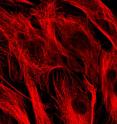Study identifies critical 'traffic engineer' of the nervous system
A new University of Georgia study published in the journal Nature has identified a critical enzyme that keeps traffic flowing in the right direction in the nervous system, and the finding could eventually lead to new treatments for conditions such as Alzheimer's and Parkinson's disease. "There was no medical or any other applied science drive for this project; it was purely curiosity about how transport inside cells works," said study co-author Jacek Gaertig, professor in the cellular biology department in the UGA Franklin College of Arts and Sciences. "But it looks like we have identified an important enzyme that acts in the nervous system."
He explained that cells contain a network of tubes known as microtubules that are made of protein and serve as tracks for the shuttling of materials from one part of the cell to another. The traffic signs on this microtubule network are chemical additions such as acetylation marks. Microtubules in parts of neurons in the brain that send signals, for example, are loaded with acetylation marks. Microtubules in parts of neurons that receive signals, on the other hand, have few.
Acetylation marks were discovered in 1983, and researchers recently determined their role in regulating the binding of the motor proteins that shuttle materials along microtubules. What has been unclear for more than 25 years, however, was the cellular process by which these acetylation marks are formed. In other words, which enzyme decides where the traffic signs go?
Through a series of studies using the microscopic protozoan Tetrahymena, the nematode C. elegans, zebrafish and human cancer cells, Gaertig and his colleagues revealed that an a protein known as MEC-17 is the traffic engineer in charge of microtubule acetylation.
MEC-17 acts as an enzyme to catalyze the acetylation reaction on microtubules, and is involved in the sensation of touch in the nematode. Its depletion in zebrafish, which are commonly used as a model organism to study basic processes, results in neuromuscular defects. Importantly, several research groups have previously reported that the levels of acetylation marks on microtubules are altered in human neurodegenerative diseases such as Huntington's, Parkinson's and Alzheimer's.
Gaertig said that with the enzyme identified and its mechanism of action known, it is now possible for drug manufacturers to search for compounds that block or enhance its activity.
Graduate student Shilpa Akella and postdoctoral associate Dorota Wloga in Gaertig's lab studied the enzyme in the protozoan and in vitro, while Jihyun Kim and Natalia Starostina in the lab of Edward Kipreos, professor of cellular biology, showed how it worked in the nematode and found that the enzyme is active in human cancer cells. The lab of associate professor and Georgia Cancer Coalition Distinguished Scholar Scott Dougan deduced its role in zebrafish, and Sally Lyons-Abbott and Naomi Morrissette at the University of California-Irvine biochemically purified microtubules that are marked by MEC-17.
"Working together allowed us to use all kinds of models to establish that this microtubule acetylation process using MEC-17 is an evolutionarily conserved function," Gaertig said. "Without close collaboration, that would not have been possible."
Source: University of Georgia
Other sources
- Critical 'traffic engineer' of the nervous system identifiedfrom Science DailyFri, 10 Sep 2010, 2:21:19 UTC
- 'Traffic cop' brain enzyme identifiedfrom UPIWed, 8 Sep 2010, 21:49:22 UTC
- Study identifies critical 'traffic engineer' of the nervous systemfrom PhysorgWed, 8 Sep 2010, 17:28:08 UTC
